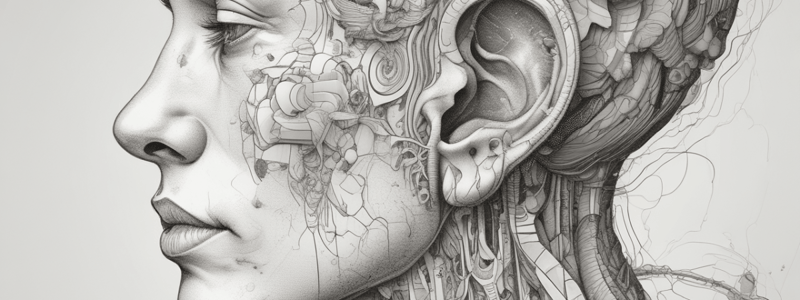Podcast
Questions and Answers
What is the function of the middle ear bones?
What is the function of the middle ear bones?
- To filter out external noise
- To amplify pressure from the eardrum to the oval window (correct)
- To protect the eardrum from damage
- To generate sound waves
How do the middle ear bones protect the ear from high amplitude vibrations?
How do the middle ear bones protect the ear from high amplitude vibrations?
- By breaking down vibrations
- By filtering external sounds
- By decreasing the size of the eardrum
- By switching to a less-efficient mode of vibration (correct)
What separates the scala vestibuli from the scala media in the inner ear?
What separates the scala vestibuli from the scala media in the inner ear?
- Basilar membrane
- Tympanic membrane
- Tectorial membrane
- Reissner membrane (correct)
Which structure generates fluid waves in the cochlea?
Which structure generates fluid waves in the cochlea?
What function do hair cells in the basilar membrane serve?
What function do hair cells in the basilar membrane serve?
Where do high frequency sounds produce the greatest motion on the basilar membrane?
Where do high frequency sounds produce the greatest motion on the basilar membrane?
How are neural impulses generated in the hair cells?
How are neural impulses generated in the hair cells?
What determines which nerve cells are fired along the Organ of Corti?
What determines which nerve cells are fired along the Organ of Corti?
Flashcards are hidden until you start studying
Study Notes
Middle Ear
- Located behind the eardrum
- Comprised of three bones: hammer, anvil, and stirrup
- Transmits vibrations from the tympanic membrane to the oval window of the inner ear
- Functions as a lever system, amplifying pressure from the eardrum to the oval window by a factor of 22
- Filters out noise generated in the body
- Protects the ear from high amplitude vibrations by switching to a less-efficient mode of vibration at high sound levels
Inner Ear
- Transforms sound wave energy into nerve impulses for the brain
- Components:
- Cochlea: a snail-shaped structure generating fluid waves from the stapes' movement
- Reissner Membrane: separates the scala vestibuli from the scala media
- Basilar Membrane: separates the scala media from the scala tympani and contains sensory cells
- Basilar Membrane functions:
- Contains outer and inner hair cells responding to different frequencies
- Hair cells are covered by the tectorial membrane
- Vibrations cause hair cells to shear against the tectorial membrane, triggering chemical and electrical changes
- Sound Transmission:
- Sound energy causes basilar membrane vibrations
- Vibration triggers hair cell shearing and electrical charges
- Electrical charges produce neural impulses traveling along the auditory nerve to the brain
- The brain interprets these impulses as sounds
- Frequency Detection:
- High frequency sounds produce greatest motion near the oval window
- Low frequency sounds produce greatest motion near the apex
- Different areas on the basilar membrane stimulate different frequencies, resulting in varying nerve cell firings
- The brain interprets these impulses as sounds of different pitches
Studying That Suits You
Use AI to generate personalized quizzes and flashcards to suit your learning preferences.




